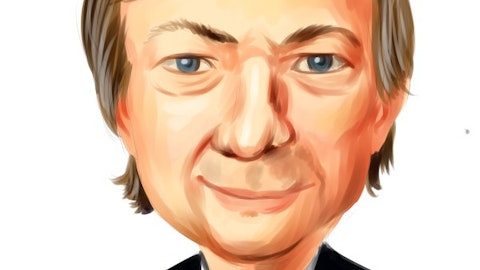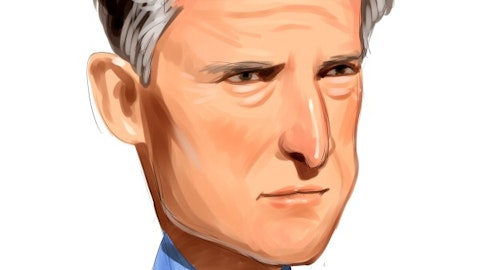Mark McGivney: Thanks Jimmy. Good morning. We certainly see continued upside in fiduciary income as we look to this year. Rates really didn’t start to move till the back half of the year as you know. And even though it seems like a little bit of slowdown in a lot of places, the expectation is rates have not peaked. And also remember even for the fourth quarter, that’s an average rate over the course of the quarter and rates moved even in the quarter. So it is something that we expect to continue to give us benefit into this year.
Jamminder Bhullar: Thank you.
John Doyle: Thanks Jimmy. Andrew, can we have the next question please?
Operator: Certainly. And our next question comes from the line of Elyse Greenspan with Wells Fargo.
Elyse Greenspan: Hi, thanks. Good morning. My first question I guess combines the expense program in some of your fiduciary investment income comments. So the expense program seems like it could be around 70 basis point tailwind to your margins in 2023. And then I would assume you would get incremental uplift from fiduciary investment income rising per Mark’s prior comments. So should we think of those two components is, a pretty good tailwind to your margin when we think about 2023 margin improvement?
John Doyle: Yes, we’re, I’m not going to give margin guidance, on the call, Elyse, and thanks for your question. Again, I think we’re well positioned. We’re in terrific businesses, just outstanding talent. And while there’s some macro uncertainty, of course, that’s out there, we expect strong revenue growth this year and we expect to increase our margins over the course of the year. Mark and I both shared a bit, what we expect to flow to the bottom line from the program this year. But we expect to maintain that discipline, that financial discipline that we’ve had for many years and to expand margin and to have strong adjusted EPS growth this year.
Elyse Greenspan: Thanks. And then my second question on, you guys talked about some pretty robust reinsurance rate increases at January 1. Have you guys seen any changes on your commission structure just given the strong pricing? Are you making any changes to help your clients in the face of that pricing? And then Mark did say that you guys, that Guy Carpenter would see pretty strong growth over the coming year. I mean, we’ve never heard, we haven’t been in an environment, right, with 40% plus price increases. How does that triangulate into organic growth within Guy Carpenter?
John Doyle: We have been in that environment before. We’ve been around a long time, but it’s been close to 20 years since we’ve operated in that kind of environment. We expect a good year of revenue growth at Guy Carpenter. As I noted in my prepared remarks ceded premiums won’t track that rate increase, right? As our insurance company clients retained more risk or have their cap programs attached at a higher level. We work with our clients, of course, to manage our compensation. We’re very transparent about that. In some cases, they’re cat commission agreements that we have with our, with our clients, but again, we expect it to be a good year for Guy Carpenter.
Elyse Greenspan: And any change in the commission structure?
John Doyle: As I said, we work through that with our clients. We have agreements with them and a very transparent dialogue about how we’re remunerated. Thank you.
Elyse Greenspan: Thank you.
John Doyle: Andrew, next question please?
Operator: And our next question comes from the line of Mike Ward with Citi.
Michael Ward: Thanks, guys. Good morning. I was wondering if you could give a sense maybe of how much more of a tail end could be left from inflation or exposures that you can see as we sit here today?
John Doyle: Thanks Mike for the question. As I noted in my prepared remarks, while we’re not immune to the macro economy, of course, there are some real factors that support growth of Marsh & McLennan. In the risk side of our business inflation is one of those areas. So, whether it’s wage inflation, core inflation, higher and of course inflation leads to higher losses and more discipline in the pricing environment. All of those issues are supportive of growth. It’s a client by client outcome though, right? Some of our clients, there are winners and losers in any economy, of course and some of those distinctions might be more stark in an economy like we’re in today. And so some are operating from a position of strength and others of course, will need to be more defensive. So we work through that with them, client by client, but broadly speaking, inflation and nominal GDP, is more indicative of demand for our revenue and our services than real GDP.
Michael Ward: Awesome, thank you.
John Doyle: Do you have a followup, Mike?
Michael Ward: Yes. Actually may be on Oliver Wyman and Mercer career, I know you mentioned a possible slowdown in Wyman, but can you talk about the pipeline and whether you’re seeing that slow down or just kind of anticipating businesses reducing their consulting appetite?
John Doyle: Sure, Mike. So let me start by just saying that Oliver Wyman is just a really important part of our value proposition for our clients and a critical part of our company. They advise the C-suite on the critical issues of the day and really help us differentiate our value proposition. We had an outstanding year of growth in 2022 on top of 21% growth in 2021 and over the midterm, medium term, we expect higher growth out of Oliver Wyman than our other businesses. So having said that, we do expect some moderation of growth. So Nick, maybe I’ll ask you to share an outlook with Mike.
Nick Studer: Yes, thanks John and thank you, Mike. As John just started to do, let me put Oliver Wyman into context. We’re very happy with a second consecutive year of double digit growth. I think it’s 15 years since we’ve achieved that. We’ve added over a third to this in that time, and we’re confident that we gained market share in what is a pretty fragmented market. And that growth was very well balanced. We grew across all our regions, across all of our capability practices and across most of our industries in 2022. But having said that, this is my seventh call, and it’s the first one that I’ve reported on something below double digit growth in the quarter. That 8% does reflect two things. We’re certainly lapping a high growth quarter, but at the same time, we did see a slowing in the pipeline as our major clients, and we pause and digest after several pretty turbulent years.
We remain optimistic in the longer-term revenue plans. Yes, there was a pretty heavy surge in the last two years, but we’ll likely revert and closer to our medium term expectations of mid-to-high single digit underlying growth through the cycle.
John Doyle: Thanks, Nick. Mike, maybe I’ll ask Martine as well to comment on Career, Mercer and I would point out Mercer had its best year of growth since 2008, so we feel absolutely terrific about it. Excellent growth in health, excellent growth in career, but Martine maybe you could share a little bit more color?





